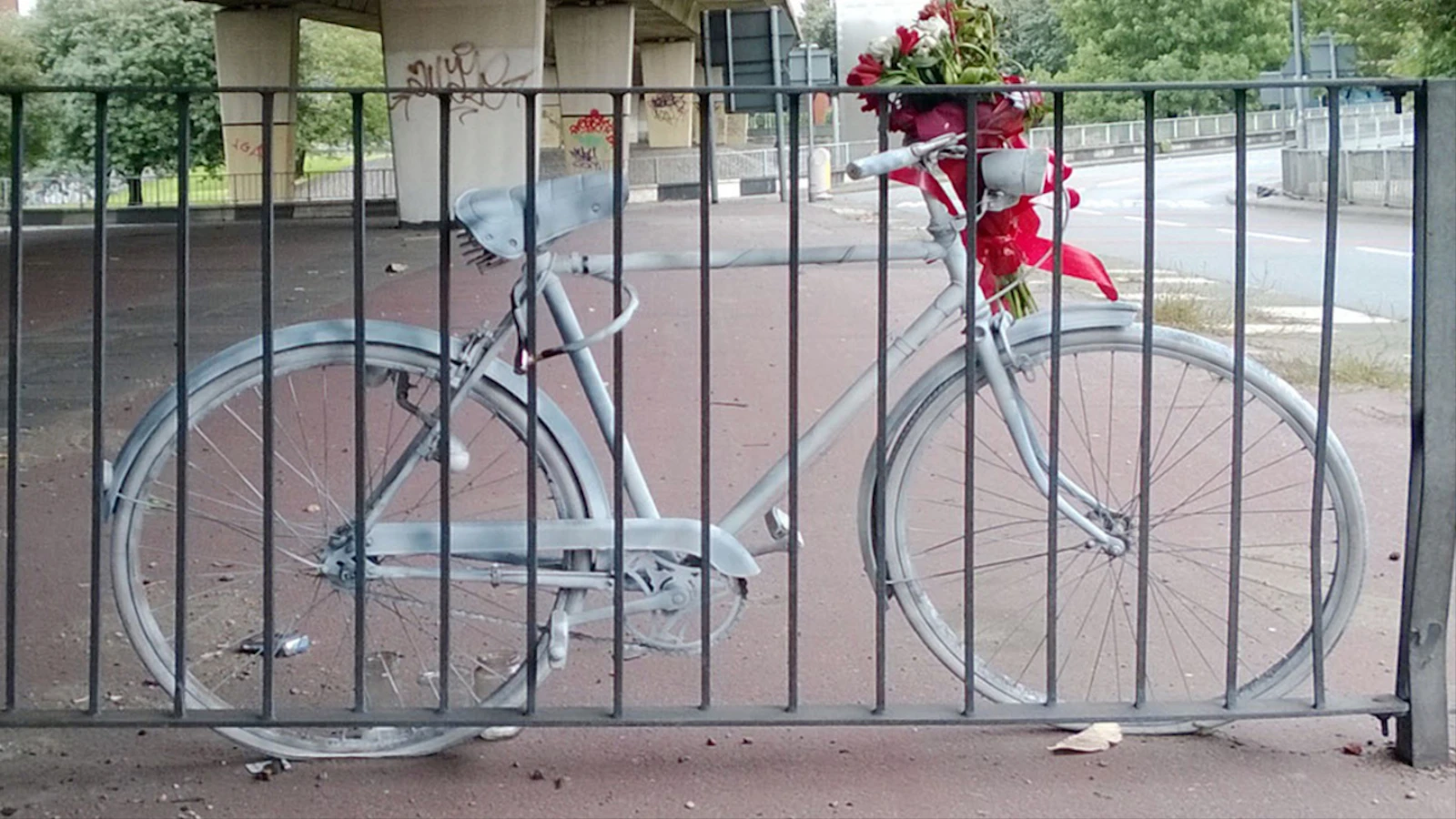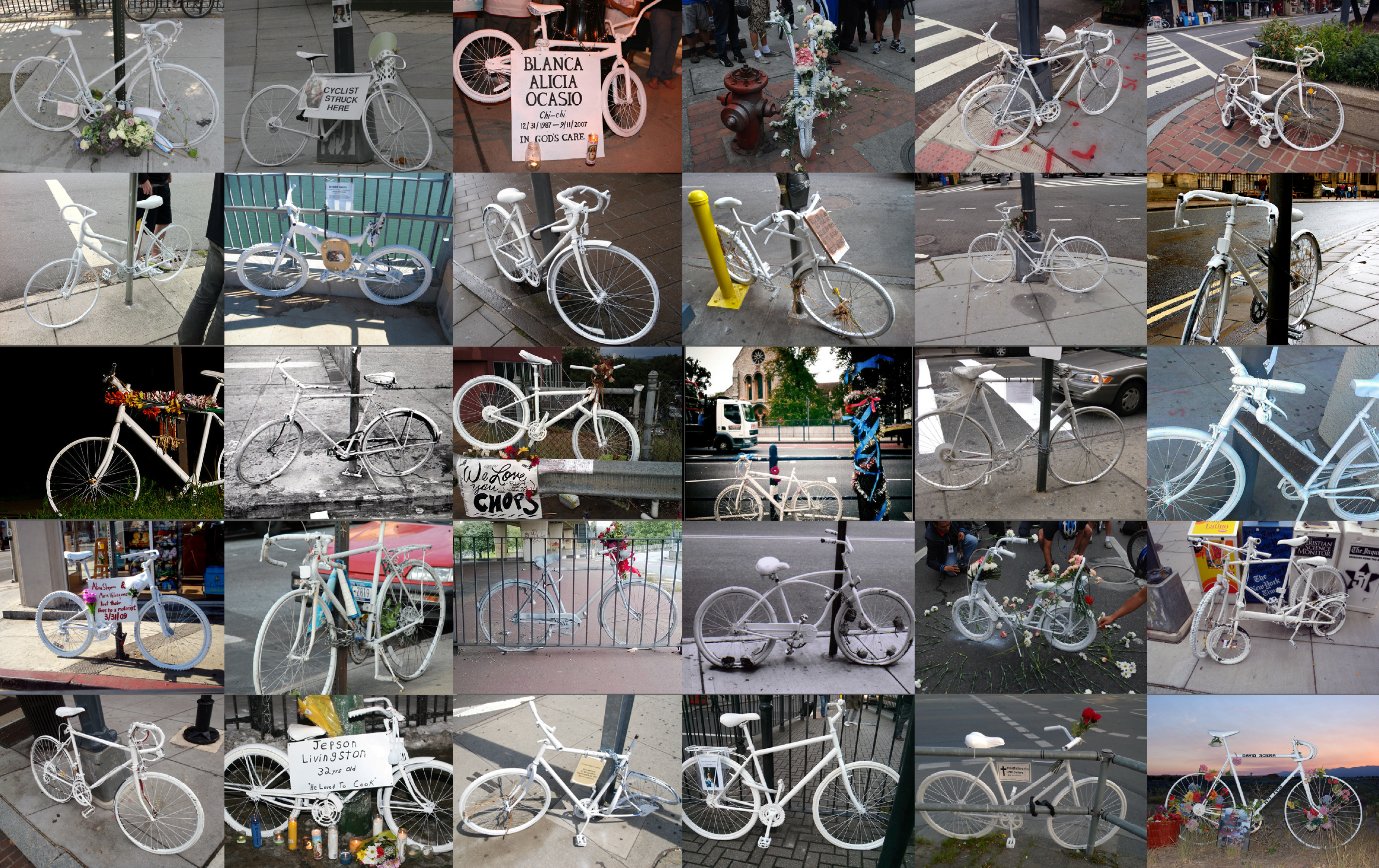
How a memorial no one wants to make comes to be.
IMAGES VIA FLICKR, STARTING TOP LEFT: CARLOS MARTINEZ, DBKING, DON SORSA, CARLOS FELIPE PARDO, DANIEL LOBO (2), CHRISTOPHER LIANG, TRACY HUNTER, ANDERS SANDBERG, JOCE01_Y, DANIEL LOBO, TODD HUFFMAN, SAM CATANZARO, OSBORNB, JON JORDAN, GARRY KNIGHT, TIMOTHY VOLLMER, DYLAN TWENEY, LORD JIM, CISC1970, JON JORDAN, CHRISTOPHER PAQUETTE, CARLOS FELIPE PARDO, DANIEL LOBO (2), DON SORSA, DAVID VAN HORN, PAUL DOWNEY, I G.
This article appears in VICE Magazine's Means of Production issue. Conceived of pre-COVID-19 and constructed during it, it explores the organization and ownership of our world.
Mirza Molberg first met Lauren Davis through a meditation group called Dharma Punx NYC. Molberg noticed, and was impressed, that Davis rode her bike to the meetings, “even in the freezing cold.” It turned out they had a lot in common: Along with an interest in Buddhism, both practiced veganism and sobriety. And, of course, there was their shared love for riding bikes.
Davis, Molberg said, was very goth. They’d go to Green-Wood Cemetery for funeral tours, and Davis had given presentations on vanitas paintings and memento mori , or reminders of the proximity of death, through the now defunct Morbid Anatomy Museum.
“We started dating, basically, through finding places to eat. We would ride almost everywhere together,” Molberg said. They’d complain about the issues of being a cyclist in New York; Molberg was hit by a car in two separate instances when they started dating, both times on the same Brooklyn street.
Since Molberg moved to New York he’s been involved with Critical Mass, a worldwide movement to reclaim the streets through massive organized bike rides. Through this, he met Jessie Singer, one of the founders of the New York City Ghost Bike Project. In 2005, Singer helped make the city's first ghost bike: a stripped-down bicycle painted white and left at the scene of a cyclist fatality as both a tribute to the life lost and a reminder for those who are still here.
On the morning of April 15, 2016, Lauren Davis was killed by a driver in the Brooklyn neighborhood of Clinton Hill while riding her bicycle. And Molberg was the one who built her ghost bike.
“[Riding a bike is] never going to be safe until improvements are made in the city and in all cities across the world. But also, I can’t stop [riding] because of these deaths. We are not the thing that needs to stop,” Molberg said. “It’s the culture that promotes the death of people. And for me to continue to ride on the streets of New York is a tribute to Lauren. It’s something that I must do. And I think to resist the worldwide culture of consumption and cars and oil, we have to ride.”
It is believed that the world’s first ghost bike appeared in St. Louis, in 2003. Patrick Van Der Tuin, then a bicycle mechanic and now the executive director of St. Louis Bicycle Works, installed it to mark the site of a nonfatal accident. After this installation was featured in Dirt Rag, a national biking magazine, the trend spread to other cities.
On June 9, 2005, Kevin Caplicki was biking to his job in Bay Ridge, Brooklyn, when his commute brought him to the scene of an accident. A fellow cyclist, Elizabeth Padilla, lay on the side of the road, moments after she’d been fatally hit by a truck in Park Slope. He was so shaken up that he walked his bike the remaining 60 or so blocks to his job.
At the time, he was part of a collective called Visual Resistance, which formed as a response to the 2004 Republican National Convention in New York. The group made political street art about a large number of issues, including neighborhood rezoning, public rights to space, and antiwar efforts. Around this time, the NYPD was making arrests at Critical Mass bike rides; Caplicki himself was arrested in April 2005. The title of a 2004 opinion piece in the New York Daily News from Raymond Kelly, then commissioner of the NYPD, read “BE OUR GUEST: Extremists Have Hijacked the Bike Rides.” This treatment, along with several cyclist deaths in quick succession, pushed the collective to “respond in the way that we knew how,” Caplicki said. A couple of weeks after Padilla was killed, the collective assembled and installed a memorial to her, the first of its kind in New York.
In the beginning, every member of the Visual Resistance was a cyclist, and there was a chilling feeling of “this could be us” every time they installed a new bike. As other cyclist advocacy groups, such as TIME’S UP! and Transportation Alternatives, became aware of the effort, some of their members started getting involved, according to Caplicki. Now the loose organization of core members and volunteers is known as the Ghost Bike Project.
Ghost bikes are important but oft-overlooked memorials, and they require materials, planning, and manpower. The bikes used are almost always donated, though on occasion the group uses the bike of the cyclist who was killed. To deter theft, all working and useful parts are stripped, and then the bike is spray-painted white. The bike is then transported by a volunteer to the scene of the accident, where it is chained to a nearby street sign, and a plaque is installed noting that a cyclist was killed at that location.
The bikes are typically made on “work days,” which are organized several times throughout the year. During these work days, volunteers gather to create ghost bikes for cyclists killed since the last work day, and, less often, to build replacement bikes for those damaged or removed from their location. Sometimes family members of a killed cyclist, activists, or public officials will request a ghost bike. Otherwise, the group will work through a backlog of fatalities recorded since their last meeting.
Occasionally the ghost bikes are made in advance, in anticipation that they will be put to use later in the year, like chalk outlines for bodies that have not yet lost their warmth. When the group set up an online fundraiser in 2018, they estimated they’d need to build 15 to 25 bikes that year. There were 10 cyclist deaths in New York City in 2018, but the following year, their estimate wasn’t high enough.
Ghostbikes.org, the group’s website, explains their mission: to support survivors and leave a symbol to memorialize where a cyclist lost their life. They also have a list of demands, including new policies to protect cyclists and pedestrians. The last demand? “We want to stop having to do this.”

In 2019, 28 cyclists were killed in New York City, making it the deadliest year for cyclists since 1999, according to data from the NYC Department of Transportation. Steve Scofield, a volunteer for the Ghost Bike Project, says the deaths boil down to some sad math.
“Time is money, so you start cutting corners. It’s an unfortunate equation,” he said. “People are driving far more aggressively than they would if they didn’t have this time equals money equation hanging over their heads.”
Scofield, 69, who worked for the Metropolitan Transportation Authority for over 30 years, has been riding a bike since he was a 6-year-old in Astoria, Queens, and has been a member of Transportation Alternatives, a nonprofit that advocates for biking, walking, and public transportation, since the 1990s.
Scofield contends there have been some changes to the streets of New York that he sees as improvements, though to see them requires a wider frame of reference than most New York cyclists are able to piece together. As a bike messenger in the 70s, Scofield had to keep a separate bike in his Manhattan office; he could not ride in from Astoria because the Queensboro Bridge did not have a permanent bike path until 2000. He also mentioned the increase in painted bike lanes, “which give [cyclists] some legitimacy,” though he said not enough people pay attention to them.
As a volunteer for the Ghost Bike Project, he retrieves bikes from Recycle-a-Bicycle in Long Island City and drops them off at the Greenpoint Reformed Church, where members of the group and other volunteers gather for their work days. Scofield also helps install the ghost bikes at their final sites, and can recall the coordinates and names of numerous victims from memory.
The ghost bike installations can be public-official-accompanied vigils or a task for a solitary volunteer. As Molberg explained, sometimes volunteers cycle to the location while keeping one hand on the ghost bike’s handlebars, called “ghost riding.”
“That’s probably the most powerful imagery, when you get someone actually holding onto that bike in memorial for someone who was killed as they’re riding to the site. It’s also probably the most dangerous,” Molberg said.
When Molberg made a ghost bike for Lauren Davis, he contacted Reverend Ann Kansfield, who has been a liaison between the Ghost Bike Project and the Greenpoint Reformed Church.
“I love that our church gets to host the Ghost Bikes,” Kansfield said. “I feel like it’s one of our most sacred ministries, even though the vast majority of people involved with the Ghost Bikes are not necessarily people of faith. They do really sacred work, and I’m so grateful that our little church gets to be able to support them in their effort.
“For a group that’s ostensibly engaged in a sad and sorrowful task, they are the most delightful and full-of-life people,” she continued, describing the group as emitting a powerful sense of camaraderie and togetherness.
This past January, Molberg began courses in thanatology—the study of death, dying, and mourning—at Brooklyn College. Between his academic work and his volunteering with the Ghost Bike Project, he’s surrounded himself with the concept of mortality. “It’s been beneficial for me to explore this subject for my own grief work.”
Molberg still visits Davis’ ghost bike in Clinton Hill, and said he often hears children asking their parents what it is. “I’ll hear an honest explanation of what this means. And I think that’s important. When people see ghost bikes, it’s important for them to acknowledge that’s where a person was killed,” he said. Though the bikes can be seen as a grim gesture, Molberg also hopes they can be something else: a reminder for people “to slow down, to acknowledge each other.”
Follow Ashwin Rodrigues on Twitter.
This article originally appeared on VICE US.









